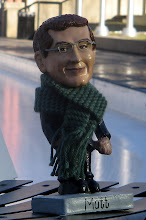 As you see here, I have only one note to play in the John Cage piece 23, to be performed tomorrow on the Spoleto Music in Time series. The other 22 string players have more notes to play, but not that many more. We each get to decide when to begin and end our notes - in my case, I can begin my mezzo-forte D any time after 1:00 but before 1:45. I could continue playing it for the entire length of the piece. Or I could play it for just a moment, and spend the remaining 22 minutes listening to everyone else. And probably wondering if I should have played a bit longer.
As you see here, I have only one note to play in the John Cage piece 23, to be performed tomorrow on the Spoleto Music in Time series. The other 22 string players have more notes to play, but not that many more. We each get to decide when to begin and end our notes - in my case, I can begin my mezzo-forte D any time after 1:00 but before 1:45. I could continue playing it for the entire length of the piece. Or I could play it for just a moment, and spend the remaining 22 minutes listening to everyone else. And probably wondering if I should have played a bit longer.That was the case in rehearsal the other day. I ended a bit past 8 minutes, and spent the next 15 minutes in thoughtful silence. The magic of the piece, it seems to me, is in the constantly evolving sonority. It is often difficult to tell where a given note is coming from, with the instruments scattered around the space. And of course, the performance we'll give tomorrow can never be replicated, because of the hundreds of variables involved. Like other Cage pieces, the beauty is as much in the thought and philosophy as in the sound.
I'm hoping the audience will see that beauty. The other piece on the program, Philip Glass' Symphony no. 3, features a lot more notes, many of them quite difficult. Those I'm pretty sure how to end, though; with this Cage note, it's anybody's guess.



 Technorati Link Count: no. of blog reactions to this post
Technorati Link Count: no. of blog reactions to this post
2 comments:
Were you ever told how Cage selected the notes to be played?
It's a D!
You've gotta love Cage. I also love the 'how did he choose the notes?' question. It's a good question for any composer, right? I wonder how Mozart chose notes.
One thang is f'sho, though: D is always a good choice.
Post a Comment